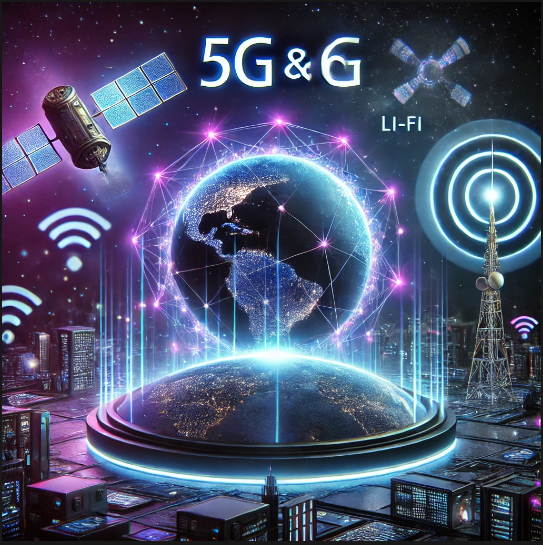Introduction
The evolution of wireless communication has significantly transformed the way we connect, communicate, and access information. The advent of 5G technology has brought unprecedented speed, low latency, and increased network capacity. However, as the demand for higher connectivity continues to grow, research is already underway to develop next-generation technologies such as 6G, Li-Fi, and Satellite Internet. These emerging innovations aim to address the limitations of existing networks and create a hyper-connected world.
This article explores the fundamentals of 5G, the advancements in 6G, Li-Fi, and Satellite Internet, along with their advantages, challenges, and the global scenario surrounding their development and deployment.
Understanding 5G Technology
1. What is 5G?
5G is the fifth-generation wireless technology that succeeds 4G LTE. It enhances mobile broadband experiences by providing ultra-fast speeds, reduced latency, and improved network efficiency.
2. Key Features of 5G
- High Speed: Capable of speeds up to 10 Gbps, significantly faster than 4G LTE.
- Low Latency: Reduces latency to as low as 1 millisecond, improving real-time applications like gaming and autonomous vehicles.
- Massive Connectivity: Supports a vast number of connected devices per square kilometer, benefiting IoT and smart cities.
- Network Slicing: Allows different use cases (e.g., healthcare, industrial automation) to have dedicated virtual networks within the same infrastructure.
- Improved Energy Efficiency: Designed to consume less power while offering higher performance.
3. Advantages of 5G
- Faster mobile broadband for enhanced user experience.
- Enables ultra-reliable low-latency communications (URLLC) for applications like remote surgeries and autonomous driving.
- Strengthens the Internet of Things (IoT) ecosystem by connecting billions of devices.
- Improves efficiency in industries such as healthcare, manufacturing, and logistics.
4. Challenges of 5G
- Infrastructure Costs: The deployment of 5G requires extensive infrastructure upgrades, making it costly.
- Spectrum Availability: 5G requires a wide range of spectrum bands, and allocation varies by country.
- Security Concerns: Higher connectivity increases the risk of cyber threats and data breaches.
- Limited Coverage: 5G’s high-frequency mmWave bands have a shorter range, necessitating more base stations.
Beyond 5G: Exploring Future Technologies
1. 6G Technology – The Next Evolution
While 5G is still being rolled out globally, researchers are already working on 6G, expected to be deployed by 2030. 6G will push wireless capabilities even further by leveraging AI-driven networks, terahertz (THz) frequencies, and quantum communication.
Key Features of 6G
- Speeds exceeding 100 Gbps for near-instantaneous data transfer.
- Ultra-low latency below 0.1 ms, making real-time interactions seamless.
- AI-powered network management for self-optimizing and adaptive systems.
- Integration with quantum computing for ultra-secure communication.
- Holographic communication allowing high-quality virtual interactions.
Advantages of 6G
- Enables immersive virtual and augmented reality experiences.
- Facilitates real-time human-to-machine interactions for Industry 5.0.
- Enhances edge computing, reducing dependency on cloud-based processing.
- Supports fully autonomous vehicles with highly reliable network performance.
Challenges of 6G
- High R&D Costs: Requires significant investment in research and development.
- Spectrum Management: THz frequencies have high propagation losses, demanding innovative solutions.
- Implementation Complexity: Integrating AI, quantum communication, and advanced computing presents technical difficulties.
2. Li-Fi – Light Fidelity Wireless Communication
Li-Fi (Light Fidelity) is a wireless technology that uses visible light communication (VLC) instead of radio waves to transmit data. It offers high-speed internet using LED light bulbs as data transmitters.
Key Features of Li-Fi
- Speeds up to 224 Gbps, significantly faster than Wi-Fi.
- Secure connectivity since light-based communication does not penetrate walls.
- Reduced electromagnetic interference, making it ideal for hospitals and aircraft.
- Highly energy-efficient, using existing LED lighting infrastructure.
Advantages of Li-Fi
- Provides ultra-fast and secure data transmission.
- Works well in radio frequency-sensitive environments.
- Reduces network congestion by offloading traffic from Wi-Fi networks.
- Eco-friendly due to efficient power utilization.
Challenges of Li-Fi
- Requires line-of-sight connectivity, limiting mobility.
- Limited coverage range, as light cannot pass through obstacles.
- Infrastructure adaptation is needed for widespread deployment.
3. Satellite Internet – Connecting the Unreachable
Satellite Internet is an advanced communication technology that uses low-Earth orbit (LEO) satellites to provide broadband services, particularly in remote and underserved areas.
Major Satellite Internet Providers
- Starlink (SpaceX): Provides global broadband internet using thousands of LEO satellites.
- OneWeb: Aims to bridge the digital divide by deploying a constellation of satellites.
- Amazon’s Project Kuiper: Plans to launch thousands of satellites to offer global connectivity.
- Telesat and China’s GW: Competing for market share in space-based internet services.
Advantages of Satellite Internet
- Provides connectivity in remote and rural areas where fiber-optic infrastructure is unfeasible.
- Low-latency connections compared to traditional geostationary satellites.
- Supports disaster recovery efforts by providing internet access in affected areas.
- Scalable technology that can expand coverage without significant terrestrial infrastructure.
Challenges of Satellite Internet
- High deployment costs for satellite launches and maintenance.
- Limited bandwidth compared to fiber-optic networks.
- Latency concerns, although LEO satellites mitigate this issue.
- Space debris risks due to increasing satellite constellations.
The Global Scenario: 5G, 6G, Li-Fi, and Satellite Internet
1. Countries Leading in 5G and 6G
- United States: Companies like Verizon and AT&T are expanding 5G, while research on 6G is led by DARPA and major telecom firms.
- China: Huawei and ZTE dominate 5G infrastructure and are investing heavily in 6G development.
- South Korea & Japan: Leaders in commercial 5G deployment, with ambitious plans for 6G by 2030.
- European Union: The EU has launched projects like Hexa-X for 6G research and development.
- India: Rapidly expanding 5G deployment and establishing a national framework for 6G research.
2. Global Investments in Next-Gen Connectivity
- 6G Research: Countries are investing billions in 6G, with partnerships between governments, telecom firms, and research institutions.
- Li-Fi Adoption: Some European and Asian companies are experimenting with Li-Fi integration in smart homes and offices.
- Satellite Internet Expansion: SpaceX’s Starlink and OneWeb are competing to provide global coverage, with governments investing in satellite communication.
Conclusion
The evolution of wireless technology from 5G to 6G, Li-Fi, and Satellite Internet is reshaping global connectivity. While 5G is still expanding, the push toward next-generation networks promises even faster speeds, reduced latency, and greater efficiency. However, challenges related to infrastructure, security, and spectrum management must be addressed to ensure seamless implementation.
The future of connectivity lies in a hybrid ecosystem where multiple technologies co-exist to provide universal, high-speed, and secure internet access. As governments and private entities continue investing in next-gen wireless innovations, the coming decade will witness a revolution in digital communication.





to address the limitations of existing networks and create a hyper-connected world?